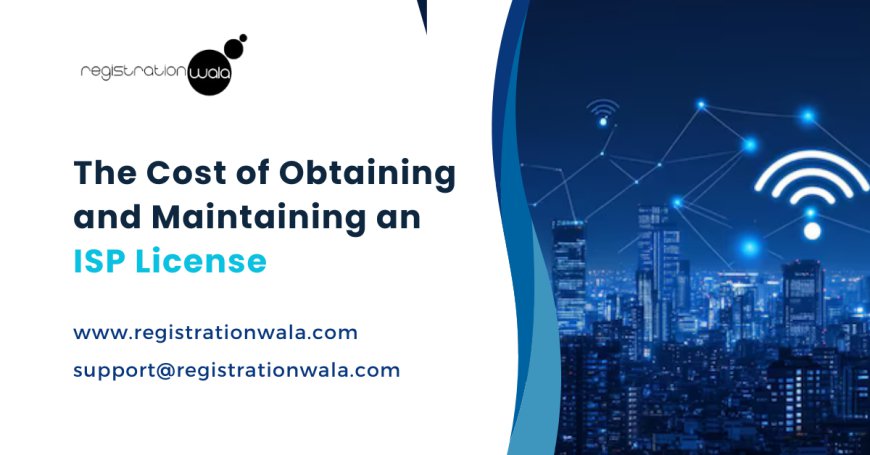The Cost of Obtaining and Maintaining an ISP License: Budgeting and Financial Planning
want to get ISP license, you also must know the cost of obtaining and maintaining an ISP license.

Starting an Internet Service Provider (ISP) can be a lucrative venture, but it involves several legal and regulatory requirements, one of which is obtaining an ISP license. The process of acquiring this license, along with the financial planning needed for both securing and maintaining it, is essential for the long-term sustainability of the business. In this article, we will explore the costs associated with obtaining and maintaining an ISP license, along with the necessary budgeting strategies to ensure a stable and compliant operation.
Understanding the ISP License
An ISP license is a legal authorization granted by the government or a regulatory body, allowing a company to provide internet services within a particular geographical area. The specific requirements and costs of acquiring this license vary depending on the country and region. However, there are common financial aspects associated with obtaining and maintaining an ISP license that businesses need to consider.
Costs Involved in Obtaining an ISP License
-
Initial Application Fees The first cost to consider when planning for an ISP license is the application fee. The fee varies depending on the regulatory body issuing the license. In some countries, this could be a significant amount, while in others, it might be more affordable. For example, in the U.S., obtaining a license from the Federal Communications Commission (FCC) might involve an extensive approval process with specific costs attached to various licenses depending on the service area size and frequency bands.
-
Legal and Consultancy Fees Navigating the regulatory environment requires legal expertise. Most ISPs hire legal and consulting services to help with the preparation and submission of their license applications. This cost can range from a few thousand to tens of thousands of dollars, depending on the complexity of the application process and the level of expertise required.
-
Government Compliance Fees Apart from the application fee, governments may charge other compliance fees, such as spectrum allocation costs, infrastructure approvals, or environmental assessments. These fees can be substantial, especially for companies operating on a larger scale.
-
Equipment and Infrastructure Investments Although not directly related to the ISP license, setting up the infrastructure to comply with licensing requirements involves significant investment in equipment, such as servers, routers, fiber-optic cables, and towers. This is a necessary cost to consider when planning for ISP operations, and the total expenditure can run into the millions for large-scale providers.
Ongoing Costs to Maintain an ISP License
-
Annual Renewal Fees After acquiring the ISP license, companies must renew it regularly, often on an annual basis. The renewal fee is typically lower than the initial application cost but still represents a significant financial obligation. Failing to renew the license on time can lead to penalties or even revocation of the license, which could halt business operations.
-
Compliance and Regulatory Audits Regulatory bodies often conduct periodic audits to ensure that ISPs are adhering to the terms of their licenses. Maintaining compliance with these regulations requires ongoing administrative work, legal oversight, and sometimes additional technical upgrades. These activities can incur costs for the business, including legal fees and operational adjustments.
-
Infrastructure Maintenance Maintaining an ISP license goes beyond compliance. The infrastructure necessary to deliver reliable internet service must be regularly updated and repaired. Equipment such as servers, cables, and networks will depreciate over time, and planning for periodic maintenance, upgrades, or replacements is essential for ensuring service quality and adherence to licensing standards.
-
Staffing Costs Running an ISP requires a qualified workforce, including engineers, technicians, customer service representatives, and regulatory compliance experts. Budgeting for ongoing staff costs is vital, as retaining skilled personnel ensures that the ISP remains compliant and able to respond to regulatory changes quickly.
Budgeting and Financial Planning for an ISP License
Given the multitude of costs associated with obtaining and maintaining an ISP license, creating a detailed financial plan is critical for success. Here are some key steps in budgeting and financial planning:
-
Assess the Initial Investment Before launching an ISP, it’s essential to calculate the total initial investment, which includes not only the cost of the ISP license but also infrastructure, legal fees, and consulting services. This ensures that there is sufficient capital to complete the setup without unexpected financial shortfalls.
-
Prepare for Ongoing Expenses The costs of maintaining an ISP license, including renewal fees, equipment maintenance, staffing, and audits, should be factored into your long-term budget. Ensure that there are enough cash reserves to handle any unexpected regulatory requirements or infrastructure issues.
-
Monitor Regulatory Changes Governments and regulatory bodies often update the rules governing ISPs. It’s essential to monitor these changes and plan for any financial impact they may have. This might involve new compliance requirements, additional audits, or increased fees.
-
Diversify Revenue Streams To sustain operations and offset the costs of maintaining an ISP license, it’s wise to explore multiple revenue streams. Offering additional services, such as web hosting, cloud solutions, or bundled telecommunications services, can help stabilize cash flow and reduce financial strain during lean periods.
-
Engage in Strategic Partnerships Partnering with other companies or municipalities can help spread the cost of infrastructure investment and compliance. Joint ventures with technology providers or local governments can also provide access to funding or cost-sharing opportunities for network expansion.
Conclusion
The cost of obtaining and maintaining an ISP license is a significant financial commitment that requires careful planning. While the initial application fees and legal costs might seem daunting, the ongoing expenses for license renewal, regulatory compliance, and infrastructure maintenance are just as critical. By creating a comprehensive financial plan, anticipating long-term costs, and exploring revenue diversification strategies, ISPs can ensure they remain financially sustainable while complying with all licensing requirements.

 manish
manish